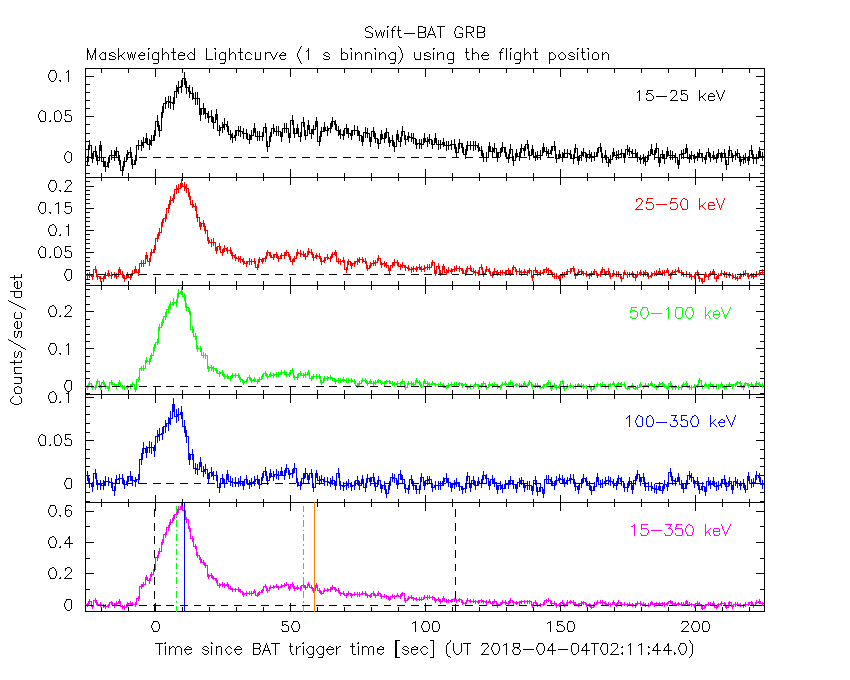
S.J. LaPorte (PSU), D.N. Burrows (PSU) and M.H. Siegel (PSU) for the Swift team
At 02:11:44 UT, the Swift Burst Alert Telescope (BAT) triggered and located GRB 180404B (trigger=821902) (LaPorte et al. GCN Circ. 22590). Swift slewed immediately to the burst. At the time of the trigger, the initial BAT position was 66° from the Sun (2.7 hours East) and 115° from the 86%-illuminated Moon. Table 1 contains the best reported positions from Swift, and the latest XRT position can be viewed at http://www.swift.ac.uk/xrt_positions.
LaPorte et al. (GCN Circ. 22590) reported the discovery with UVOT of an optical afterglow. Table 2 is a summary of GCN Circulars about this GRB from observatories other than Swift.
Standard analysis products for this burst are available at https://gcn.gsfc.nasa.gov/swift_gnd_ana.html.
As reported by Cummings et al. (GCN Circ. 22601),
the BAT ground-calculated position is RA, Dec = 53.390, -50.213 deg which is RA(J2000) = 0
The mask-weighted light curve (Figure 1) shows a major pulse that starts at ~ T-6 s and peaks at ~ T+ 10 s.
Another weaker pulse arises at the end of the major pulse at ~ T+40 s.
The second pulse peaks at ~ T+50 s and lasts until ~ T+200 s.
The time-averaged spectrum from T-5.91 to T+195.64 s is best fit by a simple power-law model.
The power law index of the time-averaged spectrum is 1.35 ± 0.04.
The fluence in the 15-150 keV band is 1.20 ± 0.02 x 1
The results of the batgrbproduct analysis are available at https://gcn.gsfc.nasa.gov/notices_s/821902/BA/.
Analysis of the initial XRT data was reported by Burrows et al. (GCN Circ. 22598). We have analysed 24 ks of XRT data for GRB 180404B, from 63 s to 327.6 ks after the BAT trigger. The data comprise 349 s in Windowed Timing (WT) mode (the first 5 s were taken while Swift was slewing) with the remainder in Photon Counting (PC) mode. The enhanced XRT position for this burst was given by Beardmore et al. (GCN Circ. 22594).
The late-time light curve (Figure 2) (from T0+5.2 ks) can be modelled with a power-law decay with a decay index of α=1.27 (+0.09, -0.08).
A spectrum formed from the WT mode data can be fitted with an absorbed power-law with a photon spectral index of 1.61 ± 0.04. The best-fitting absorption column is 3.00 (+0.25, -0.23) x 1
A summary of the PC-mode spectrum is thus:
Total column: 4.0 (+0.7, -0.6) x 1
Galactic foreground: 1.1 x 1
Excess significance: 10.4 σ
Photon index: 2.06 (+0.14, -0.13)
The results of the XRT team automatic analysis are available at http://www.swift.ac.uk/xrt_products/00821902.
The Swift/UVOT began settled observations of the field of GRB 180404B 82 s after the BAT trigger
(Siegel and LaPorte GCN Circ. 22611).
A fading source consistent with the XRT position (Beardmore et al. GCN Circ. 22594) is detected in the initial UVOT exposures.
Table 3 gives preliminary
magnitudes using the UVOT photometric system
(Breeveld et al. 2011, AIP Conf. Proc., 1358, 373).
No correction has been made for the expected extinction in the Milky Way
corresponding to a reddening of

Figure 1. The BAT
mask-weighted light curve in the four individual and total
energy bands. The units are counts

Figure 2. The XRT light curve.
Any data from a crosshatched region are not included in the fit.
| RA (J2000) | Dec (J2000) | Error | Note | Reference |
|---|---|---|---|---|
| 0 |
-50°12'54.2" | 0.46" | UVOT-refined | Siegel and LaPorte GCN Circ. 22611 |
| 0 |
-50°12'55.6" | 1.4" | XRT-final | UKSSDC |
| 0 |
-50°12'55.8" | 2.9" | XRT-enhanced | Beardmore et al. GCN Circ. 22594 |
| 0 |
-50°12'47.4" | 1.0' | BAT-refined | Cummings et al. GCN Circ. 22601 |
| Band | Authors | GCN Circ. | Subject | Observatory | Notes |
|---|---|---|---|---|---|
| Optical | Lipunov et al. | 22596 | MASTER-OAFA OT observation | MASTER | |
| Gamma-ray | von Kienlin | 22597 | Fermi GBM observation | Fermi GBM | Fluence=3.3±0.4x1 (4 |
| Gamma-ray | Svinkin et al. | 22609 | Konus-Wind observation | Konus-Wind | Duration=~29 seconds Fluence=2.60(-0.16,+0.18)x1 |
| Gamma-ray | Sharma et al. | 22645 | AstroSat CZTI detection | CZTI |
| Filter | Exp(s) | Mag | ||
|---|---|---|---|---|
| white (fc) | 82 | 231 | 147 | 18.66 ± 0.09 |
| white | 82 | 1720 | 411 | 19.39 ± 0.09 |
| white | 6421 | 6620 | 196 | >20.7 |
| v | 624 | 7031 | 510 | >19.5 |
| b | 550 | 7661 | 322 | >20.3 |
| u (fc) | 295 | 545 | 245 | 19.49 ± 0.31 |
| u | 295 | 1670 | 343 | 19.70 ± 0.29 |
| u | 6011 | 7648 | 393 | >20.1 |
| w1 | 674 | 7442 | 510 | >20.6 |
| m2 | 1600 | 7236 | 413 | >20.5 |
| w2 | 600 | 6826 | 452 | >20.2 |
Table 3. UVOT observations reported by Siegel and LaPorte (GCN Circ. 22611). The start and stop times of the exposures are given in seconds since the BAT trigger. The preliminary detections and 3-σ upper limits are given. No correction has been made for extinction in the Milky Way.
April 17, 2018